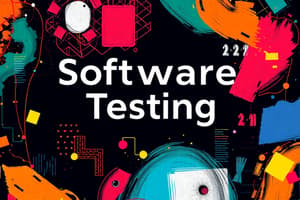Podcast
Questions and Answers
What type of testing involves testing individual units of code?
What type of testing involves testing individual units of code?
- Integration Testing
- System Testing
- Acceptance Testing
- Unit Testing (correct)
Which testing technique involves testing with knowledge of the internal workings of the system?
Which testing technique involves testing with knowledge of the internal workings of the system?
- White Box Testing (correct)
- Gray Box Testing
- Black Box Testing
- Integration Testing
What is the purpose of system integration testing?
What is the purpose of system integration testing?
- To test how components interact with each other (correct)
- To test acceptance criteria
- To test individual components of the system
- To test the entire system
What test case design technique involves dividing input data into partitions?
What test case design technique involves dividing input data into partitions?
What is test data used for?
What is test data used for?
Which type of testing ensures that the system meets the acceptance criteria and is ready for release?
Which type of testing ensures that the system meets the acceptance criteria and is ready for release?
Flashcards are hidden until you start studying
Study Notes
Types of Testing
- Unit Testing: Testing individual units of code, such as functions or methods, to ensure they function as expected.
- Integration Testing: Testing how different units of code work together to ensure seamless integration.
- System Testing: Testing the entire system, including all components and interactions, to ensure it meets requirements.
- Acceptance Testing: Testing to ensure the system meets the acceptance criteria and is ready for release.
Testing Techniques
- Black Box Testing: Testing without knowledge of the internal workings of the system.
- White Box Testing: Testing with knowledge of the internal workings of the system.
- Gray Box Testing: Testing with partial knowledge of the internal workings of the system.
Testing Levels
- Component Testing: Testing individual components of the system.
- System Integration Testing: Testing how components interact with each other.
- System Testing: Testing the entire system.
Test Case Design Techniques
- Equivalence Partitioning: Divide input data into partitions and test each partition at least once.
- Boundary Value Analysis: Test at the boundaries of input data.
- State Transition Testing: Test different states of the system and transition between them.
Test Data Management
- Test Data: Data used to test the system, including input data, expected results, and sample data.
- Test Environment: The environment in which testing takes place, including hardware, software, and network configurations.
Defect Management
- Defect: A flaw or error in the system.
- Defect Reporting: Documenting and reporting defects found during testing.
- Defect Tracking: Tracking and managing defects from identification to resolution.
Studying That Suits You
Use AI to generate personalized quizzes and flashcards to suit your learning preferences.



